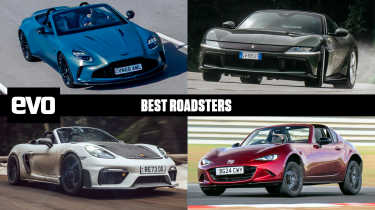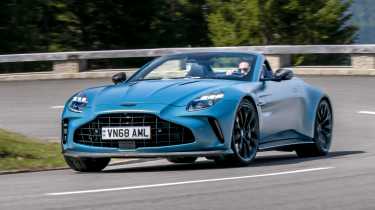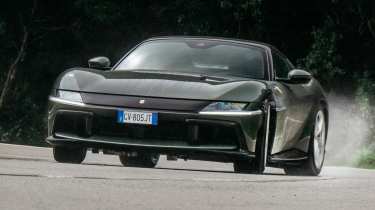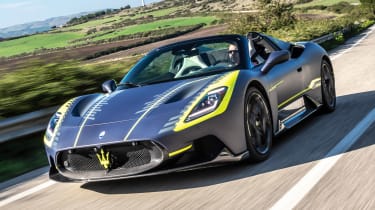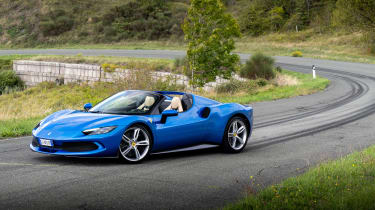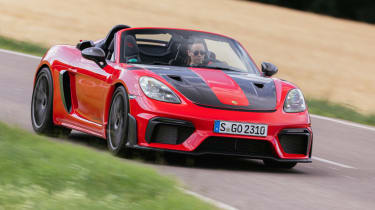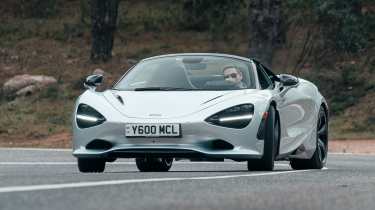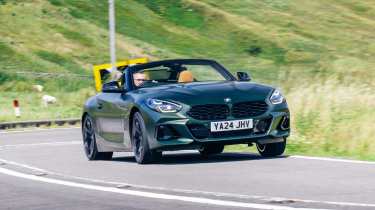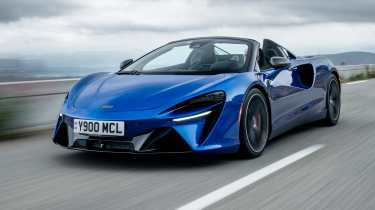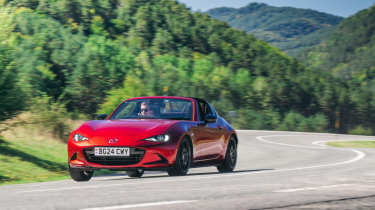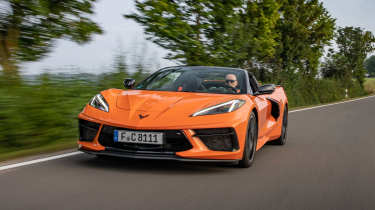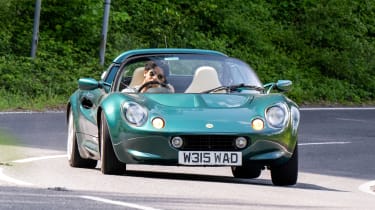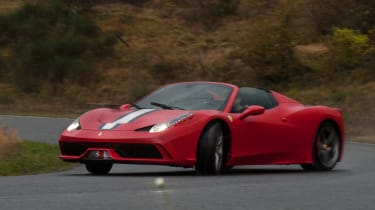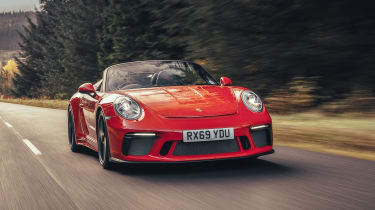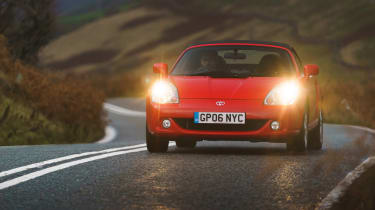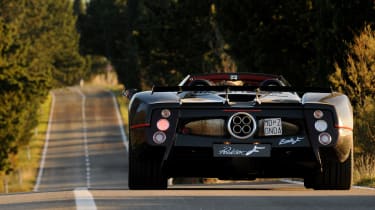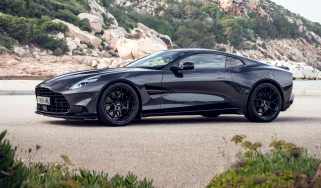Best roadsters 2025 – performance cars for the summer sun
The best roadsters offer big thrills with minimal compromises – these are evo’s favourites from the present and past
There are fewer and fewer convertibles and roadsters being built these days but there are still plenty of delectable drop tops to choose from. No doubt, the early spring sun will have many enthusiasts perusing what the market has to offer at the moment, with the Aston Martin Vantage Roadster and the Ferrari 12 Cilindri Spider hitting forecourts just in time.
But what’s the difference between a roadster and a convertible? In truth, there are no hard and fast rules that put a car in one category or the other, but we’d argue that roadsters are the more overtly dynamic and sporting in nature and happen to have removable roofs. Convertibles are sometimes, but not always, based on slightly more prosaic saloons or grand tourers and while there’s nothing wrong with that it’s the roadsters that offer the ultimate in thrills.
In the UK you could argue that roadsters are aimed at the eternal optimist. But believe it or not, this country has the second highest ratio of drop-tops per capita of any in the world, so there are plenty of glass-half-full motorists about. We should celebrate then the manufacturers who can still justify chopping the roof off various sports and supercars and these are our current favourites.
Best roadsters 2025
- Aston Martin Vantage Roadster
- Ferrari 12 Cilindri Spider
- Maserati MC20 Cielo
- Ferrari 296 GTS
- Porsche 718 Spyder RS
- McLaren 750S Spider
- BMW Z4 Handschalter
- Morgan Plus Four
- McLaren Artura Spider
- Mazda MX-5 RF
- Chevrolet Corvette
Aston Martin Vantage Roadster
Prices from £181,500
Pros – Retains all the good bits of the coupe
Cons – Ride is on the stiff side for a roadster
The latest Aston Martin Vantage is the poster child of Aston Martin’s rejuvenation, being such a complete turnaround compared to its predecessor in spite of quite obviously sharing its bones. The bump up in power of over 150bhp is only the start, with the Vantage being a more exciting, yet more exploitable supercar-bothering sports car, that’s traditionally prettier with much better tech, fit and finish inside. The Roadster carries on the coupe’s fine form, compromising very little dynamically and improving the UI with easier-to-read graphics.
‘The Vantage offers a more characterful alternative to the McLaren Artura Spider or a used Maserati MC20 Cielo. The former might have the Aston’s number in ultimate dynamics and pace and the latter for supercar looks, but the Vantage Roadster should be considered as a serious alternative to both.’ – Stuart Gallagher, evo editor-in-chief, who tested the Vantage Roadster on road on the launch.
Alternatives to the Aston Martin Vantage Roadster
Given its intensity as a driver’s car, the Aston Martin Vantage Roadster squares up against convertible sports cars like the Porsche 911 Carrera GTS Cabriolet and more serious metal from the supercar camp – the Maserati MC20 Cielo and McLaren Artura Spider. The McLaren oddly enough, adds a bit of refinement and real world dexterity, with its more considered ride and electric-only driving ability for limited distances.
> Aston Martin Vantage Roadster review
Ferrari 12 Cilindri Spider
Prices from £366,500
Pros – Loses none of the berlinetta’s performance
Cons – Still lacks the vocal range you expect of a V12 Ferrari
We loved the 12 Cilindri berlinetta with its 6.5-litre naturally-aspirated 819bhp V12 but as with all roadsters, we had concerns whether lopping the roof off would have a detrimental effect on the Spider. We needn’t have worried as Ferrari has gone to great lengths to ensure the drop-top is as structurally sound as the coupe, and it drives every bit as well as the hardtop.
The 12 Cilindri Spider feels more GT than hypercar and it’s all the better for it with a supple ride that belies its poise and agility when you push a little harder. Grip levels are high and it’s as refined as the coupe which is a big plus, too. Despite being hugely capable the one disappointment is that the glorious V12 isn’t a little bit more vocal – even with the roof furled and the windows down, the engine is a little muted, which is not what you want or expect from a 6.5-litre Ferrari V12.
‘The Spider is a remarkably capable front-engined supercar and a very good GT too, with an easy-going drivability and supple ride. Roof up, I’d guess it’s pretty much as refined as the berlinetta, and structurally it was solid over some dreadful surfaces.’ – John Barker, evo editor-at-large, who tested the Ferrari 12 Cilindri Spider on road on the launch.
Alternatives to the Ferrari 12 Cilindri Spider
The Ferrari 12 Cilindri Spider operates at rarified altitude in terms of price and performance, for a convertible. It has one direct rival, in the Aston Martin Vanquish Volante, which follows hot on the heels of the Ferrari with a 2025 debut. Can’t wait? The predecessors of both, the Ferrari 812 GTS and the Aston Martin DBS Volante, would be excellent punts and for half the cash. Not in a rush and have a bit more cash? You can be sure Lamborghini will introduce a popped-top Revuelto Roadster, with the only other naturally-aspirated V12 (albeit hybridised) there is in a car costing under £1million.
> Ferrari 12 Cilindri Spider review
Maserati MC20 Cielo
Prices from £252,000
Pros – All of the excellence of the coupe, with the sky overhead
Cons – Expensive; not particularly lightweight
Maserati’s new dawn got off to a stunning start with the MC20, its combination of raucous turbocharged grunt and dynamic finesse enabling it to take the 2023 eCoty crown. It’s no wonder, then, that the open-top MC20 Cielo is one of our favourite roadsters of the moment.
The Cielo is underpinned by a carbon chassis built by Dallara, which has been reinforced to mitigate the loss of rigidity from removing the roof. Weight has crept up to 1560kg (dry), and while the springs and dampers have been retuned to suit, the Cielo still captures what we love about the MC20 – namely the explosive V6 motor and wonderfully fluid chassis.
‘Where the MC20 Cielo really scores is by genuinely balancing different personalities. So often a car claimed to be a GT car one second and supercar the next just feels compromised and never hits either target. The Cielo, however, nails both.’ – Jethro Bovingdon, former evo contributor, who tested the Maserati MC20 Cielo on road on the launch.
Alternatives to the Maserati MC20 Cielo
As a V6 junior supercar, the MC20 Cielo should be a rival to Mclaren’s Artura Spider, but its £252k starting price puts it firmly in the ballpark of more senior machinery like the 750S Spider and Ferrari 296 GTS. The MC20 is a fabulous thing though, and a worthy foil for the Italian hybrid and British lightweight, if not a patch on either for performance. It’s certainly more characterful than the Artura Spider. Want something with a little less supercar stage presence? An Aston Martin Vantage Roadster is a beautiful yet intense soft-top sports car that packs supercar muscle.
Ferrari 296 GTS
Prices from £280k
Pros – No compromises over the hardtop, so makes for a stunning supercar
Cons – It's an expensive upgrade from Berlinetta to Spider
Somehow, after the brutally fast but slightly confused SF90, Ferrari pulled a blinder with its second series-production hybrid. The 296 GTB captures the noise, athleticism and sheer speed of our favourite mid-engined Berlinettas, and the Spider version adds even more drama, opening up the V6 symphony behind your head.
With the same 819bhp as the coupe, the 296 GTS feels just as intensely rapid – perhaps even more so given that it exposes you to the elements. But it’s the car’s natural balance that shines brightest, thanks to its impressively rigid structure and relatively small 70kg weight penalty over the hard-top.
‘In its heart of hearts the 296 GTS is just like the GTB. It uses its electric power to deliver a 15-mile range and that oddly calm driving experience. But it would much rather you stick the powertrain into Race mode (or even Qualifying, where you get the full 819bhp), twist the manettino past Wet and Sport and go for Race or CT Off and then just get stuck in. And you should, because the GTS is simply a fabulous car to drive with some intent.’ – Jethro Bovingdon, former evo contributor who tested the 296 GTS on road on the launch.
Alternatives to the Ferrari 296 GTS
The 296 GTS is squarely aimed at the McLaren 750S Spider as its main rival, though Lamborghini will soon join the fight with a Temerario Spyder, though that’s not due until next year. Until then, the Maserati MC20 Cielo makes a highly compelling option, albeit with less performance and for not a lot less money.
Porsche 718 Spyder RS
Prices from £125,500
Pros – Scintillating powertrain mated to sharp yet supple chassis
Cons – End of the line for internal combustion Boxster
Porsche’s entry-level roadster has morphed into an altogether more serious, hugely competent machine since the first Boxster arrived in 1996, and the 718 Spyder RS is the pinnacle of the breed. A drop-top Cayman GT4 RS in all but name, the Spyder RS gets the same 493bhp 4-litre flat-six, which revs to 9000rpm and sounds utterly sublime while doing so.
Straight-line performance is very similar to that of its hard-top stablemate, but the driving experience is a little less hardcore with more road-biased suspension and steering tuning. This is a good thing; on the road, the Spyder RS feels pure, intense and all-consuming, but without some of the harsher edges of the GT4 RS. Few – if any – modern sports cars are quite as intoxicating. As the last combustion-engined Boxster, it's a fitting send-off.
‘As an overall experience the Spyder RS is perhaps the most immediately loveable of all the current RS models. Far less intimidating or overt than the 992 GT3 RS and less of a headbanger than the GT4 RS, the inherently more carefree nature of the Boxster places fewer demands on you to channel your inner Jörg Bergmeister. The RS upgrades make it markedly more aggressive and intense, but its default is still to have fun and enjoy every moment. That’s hard not to like.’ – Richard Medan, evo co-founder and editor-at-large, who tested the 718 Spyder RS on road on the launch.
Alternatives to the Porsche 718 Spyder RS
The conundrum of picking alternatives to the Spyder RS is best exemplified by examining the competition the standard Boxster faces. Er, a Z4? There’s no Z4 M CSL brightening up BMW’s lineup, to face off the RS. So, supercars it is. The thing is, suggesting the MC20 Cielo is an option isn’t so ludicrous, given that Cielos trade on the used market for c£170k – the same as high-spec Spyder RSs. Then there’s the slightly befuddling fact that, in terms of real world power-to-weight, there’s about 10bhp/ton in it.
> Porsche 718 Spyder RS review
McLaren 750S Spider
Prices from £269,160
Pros – All of the intensity, feedback and agility of the coupe
Cons – Interior not as special as the 720S it replaced
Despite a new name and a £269,160 price tag, the McLaren 750S is very much an evolution of the 720S rather than a completely new car. For us, that can only be a good thing, because the 720S remains one of the world's greatest supercars.
For the 750S, McLaren has teased more power from its twin-turbocharged 4-litre V8 for peaks of 740bhp and 590lb ft, while also stripping out 30kg (the Spider weighs 1438kg and feels almost identical to the coupe thanks to its carbon construction). The suspension has also been revised to generate more 765LT-style sharpness and aggression, and the combined effect is one of the most thrilling and addictive open-top supercars you can buy.
‘Perhaps the most compelling argument for this car remains as it was in the 720S: it does everything. The 750S looks exotic and outrageous, it feels so special thanks to the driving environment and due to its sophisticated chassis and carbon fibre construction, it copes on road and track with equal aplomb.’ – Jethro Bovingdon, former evo contributor, who tested the McLaren 750S Spider on the road on the launch.
Alternatives to the McLaren 750S Spider
The McLaren 750S Spider was a direct riposte to Ferrari and its 296 GTS, the convertible version of its staple mid-engined supercar. The 296 is a hybrid, as will be the Spyder version of the Lamborghini Temerario when it arrives. If you want an all-motor alternative, that’s not necessarily a featherweight as a result, the Maserati MC20 Cielo isn’t far off price wise when new, though it is in the region of 130bhp down and over 200kg heavier than the McLaren.
BMW Z4 Handschalter
Prices from £65,710
Pros – Added focus; interaction of manual box; still a good GT
Cons – Still heavy, still not the most involving sports car
BMW’s Z4 has always struggled to be the driver’s car that so many wanted it to be, and the main reason for that comes in a Boxster-shaped fly in the ointment. Put simply, the Z4 has never been its equal when it comes to out-and-out driver satisfaction. The latest generation – especially in M40i form – is a decent steer, but lacked the ultimate in involvement.
That’s changed though with the introduction of the Z4 ‘Handschalter’, which literally means ‘hand-shifter’ in German. Yes, six years into its life the most powerful Z4 is finally available with a six-speed manual gearbox. It’s only available in green with a brown interior, but that third pedal provides another layer of interaction that makes the Z4 a much better car. The turbocharged straight-six is still an absolute joy to sit behind and the manual ‘box really lets you get the best from it. Additional revisions for the Handschalter include different chassis settings with mixed-size wheels, updated steering, new rear dampers and changes to the adaptive M differential. The steering’s still not perfect, but it’s comfortable, hooks up well out of corners and is a lot of fun. Still no Boxster beater though.
‘The Z4 has never been so composed but, as with other models, there’s little feedback to tell you how hard you’re pushing. So, while the Handschalter is the most accomplished and engaging Z4 yet, in large part thanks to that slick, positive and easy shift, it’s still more of a cruiser than a scratcher.’ – John Barker, evo co-founder and editor-at-large, who tested the Z4 Handschalter on the road in the UK.
Alternatives to the BMW Z4 Handschalter
The obvious alternative for the driver wanting more focus is the Porsche 718 Boxster, though for the 4-litre GTS version you’ll pay £12k more than what the manual, six-cylinder Z4 costs. For the Z4’s £65k price tag, you’ll have to settle for the four-cylinder Boxster S, which while still sharper to drive, is seriously stunted by its industrial-sounding powertrain.
Morgan Plus Four
Prices from £69,995
Pros – Lighter in body and soul than the Supersport; uniquely British
Cons – Driving experience still more Morgan than modern
As a modern open-top car to turn back the clock to the times of the MGA and Jaguar XK120, there’s nothing better than the Morgan Plus Four. Yet while this retro cabriolet might look old-world, in reality it’s more engineering is far from antiquated under that quaint exterior. That’s because in 2018, Morgan introduced a new generation of aluminium chassis, pairing that classic charm with a new construction method and thoroughly modern BMW powertrains.
The Plus Four shares its 2-litre turbocharged four-cylinder engine with many a BMW, while there’s a whole raft of new tech inside the cabin to make it a more pleasant and less compromised experience than its archaic predecessors offered. That’s especially true when equipped with the optional Dynamic Handling Pack, which adds adjustable Nitron coilovers and a rear anti-roll bar. So equipped, the Morgan is a competent driving tool as well as an endlessly characterful one and it certainly entertained in eCoty 2024, turning every journey into an enjoyable experience. The Plus Four has now been put in the shade somewhat by its all singing all dancing Supersport sibling but in a way, that’s a good thing. There’s real distance, apart from having different engines, between the two, from the dynamics, styling and interior, to the pricing.
‘We all fell for the Morgan’s charms to some degree because the Plus Four is a beautiful car, beautifully made. It’s also a car that drives like it looks, which is great… up to a point. Its handling has improved with this version but it remains a classic driving experience, even though you really can tramp on – the turbocharged four delivers huge torque and has very little mass to shove along.’ – John Barker, evo co-founder and editor at large, who tested the updated Plus Four with the Dynamic Handling Pack on 2024’s evo Car of the Year test.
Alternatives to the Morgan Plus Four
Unsurprisingly, there aren’t many direct rivals to the hand-built, old-hat, highly bespoke Plus Four. You could swap into a Caterham in search of more viscerality and raw capability, though you might miss the boutique plushness of the Morgan. Look further the other way and you move towards Porsche Boxsters and BMW Z4s, which while more polished and rounded, don’t offer the same warmth in terms of the driving and ownership experience.
McLaren Artura Spider
Prices from £221,500
Pros – Mesmerising performance, brilliant chassis upgrades, roof down thrills
Cons – V6’s soundtrack doesn’t match its performance
We immediately fell for the McLaren Artura when we first drove it, so much so that it made the podium at evo's 2022 Car of the Year test, sharing third place with Ferrari's 296 GTB. That a Spider version arrived later was no surprise, but we didn't anticipate the extensive upgrades that McLaren would apply to its baby supercar at the same time. The changes have made a stunningly fast car even quicker thanks to a power boost to 690bhp, with comprehensively reworked chassis systems designed to deliver more precision than before. The result is a car that managed a very close second at evo Car of the Year 2024.
The revised Artura is a significant step on from what was already a brilliant car, with newfound levels of finesse and sharpness to the driving experience. The best part is that thanks to a stiff carbonfibre chassis, the Spider weighs just 62kg more than the coupe and offers the same level of excitement – if not more so with unfiltered access to the tunes from its V6.
‘More than just an open-top derivative of the original Artura coupe, which finished equal third on eCoty 2022, this Spider version has been refined in many ways and its V6 hybrid electric powertrain now delivers 691bhp. It’s a handsome, exceptionally capable car with terrific feel and great refinement.’ – John Barker, evo co-founder and editor-at-large, who drove the Artura Spider on 2024’s evo Car of the Year test.
Alternatives to the McLaren Artura Spider
The Artura Spider offers a great deal of car for the money, especially when you consider the alternatives. The Maserati MC20 Cielo is much pricier than the McLaren, though is a viable option if hybrid power isn’t to your liking. If it is, then your budget needs to climb in order to get into a Ferrari 296 GTS.
> McLaren Artura Spider review
Mazda MX-5 RF 2.0
Prices from £35,015
Pros – Balanced; lightweight; superb manual gearbox
Cons – Characterless engine; heightened price
By some margin the cheapest car in this list, the MX-5 RF is still a pocketful of fun. Its diminutive proportions almost make it look three-quarter scale, and it delivers a lightweight simplicity that’s a rarity these days.
A round of updates in 2024 made it better than ever, with lightly tweaked styling and new interior tech, but most importantly a new asymmetric limited-slip diff and retuned steering. The changes make its modest performance even more easy and satisfying to access, so much so that it was a real contender for 2024 evo Car of the Year title, missing out on the top step of the podium by a whisker.
The 2-litre model generates 181bhp, but speed isn’t really the MX-5 RF’s thing – it’s all about carrying momentum and working with the biddable, roll-happy chassis. It remains as simple a recipe as ever, and there are few better ways of experiencing the charms of a rear-drive sports car at law-abiding speeds.
‘The modest 205/45 tyres are nothing special, the engine has just 181bhp and is a charisma-free zone, and yet the MX‑5 was consistently one of the most rewarding and entertaining cars on the test. I found it utterly absorbing. And it felt exactly the same in the wet, which is the hallmark of a great chassis.’ – John Barker, evo co-founder and editor-at-large, who tested the MX-5 RF on the evo Car of the Year 2024 test.
Alternatives to the Mazda MX-5 RF
The MX-5 RF in 2-litre form, especially in top-whack Homura spec that gets you the trick diff, sports suspension and Brembo brakes, seems at first to forego the price advantage that MX-5s are so celebrated for. Yet at a full-bodied £37,715, it’s still no more expensive than a VW Golf GTI and a full £20,000 less than the cheapest Porsche Boxster you can buy. It remains in a class of one, even at this level. Approach the gates of the used market and a Toyota GR86 will be there to welcome you, as well as more premium (albeit older) options like the 981 Porsche Boxster S.
Chevrolet Corvette Convertible
Prices from £113k
Pros – Naturally-aspirated V8, quality dynamics
Cons – Weird looks, hamstrung performance for Europe
Always left of field but no longer only in left-hand-drive, is the Chevrolet Corvette C8. It’s the first mid-engined Corvette, but some things don’t change – it still has a 6.2-litre pushrod V8 at its core, albeit with a dry sump. Unfortunately, the C8’s V8 has been pegged back to 475bhp in the EU for emissions reasons, meaning it’s not as potent as its 495bhp US-based counterpart.
The C8 features contemporary tech everywhere else too, with power sent to the rear wheels via an eight-speed dual-clutch transmission familiar to the Maserati MC20, while its aluminium chassis is suspended by double unequal-length wishbones at all four corners.
Even the coupe offers open-air motoring via a removable targa roof panel. For the full drop-top experience, though, you'll need to go for the Corvette Convertible with its retractable folding hard top, which also improves the looks of the slightly fussy American sports car. The Z06 and E-Ray meanwhile, offer wider bodies with either a flat-plane crank 8600rpm V8, or a hybridised version of the pushrod 6.2. They’re all really rather good too – gone are the days of American sports cars trading purely on power, with laughable dynamics. If only the steering had a bit more life to it.
‘Certainly it’s a lot more delicate in its dynamic approach than any previous Corvette, with a precision to the controls and a deftness to its responses that traditional front-engined Corvette drivers would struggle to recognise. From its steering to its brake feel (which can be adjusted via six different drive modes) to its ride – controlled on our test car by £1940 of Magnetic Ride adaptive dampers – it just works.’ – Steve Sutcliffe, former evo contributor, who tested the Corvette Convertible on the road in Europe.
Alternatives to the Corvette Convertible
What isn’t totally preserved is the value proposition Corvettes have always boasted. A delivery miles Corvette Convertible will set you back upwards of £113,000, or roughly what you’ll pay to order a new Porsche 911 Carrera Cabriolet. That said, a base Carrera is 90bhp down on the Corvette – you’ll need the £130k Carrera S Cabriolet to match it for potency.
> Chevrolet Corvette Convertible review
Best used roadsters
- Lotus Elise S1
- Ferrari 458 Speciale Aperta
- Porsche 911 Speedster
- Toyota MR2 (Mk3)
- Pagani Zonda F Roadster
Lotus Elise S1
It’s not a stretch to suggest that Lotus might not be with us today if not for the dinky, lightweight hero that is the Series 1 Elise. Born from a tight budget and ingenious thinking, the first Elise set the tone for the next two decades of Lotus, rewriting just how good a small roadster can be.
The ingredients – two seats, a glassfibre body and a 118bhp Rover K-series motor – were simple, the execution masterful. Delicate across the ground yet seeping with feel, the Elise weighed just 731kg thanks to its extruded aluminium chassis; later S2 and S3 cars were heavier, but the original’s pure ethos remained. It remains one of the most absorbing sports cars at any price, firmly in the realm of evo legends.
Ferrari 458 Speciale Aperta
The 458 Speciale represents a high point for V8 Ferraris before turbocharging swept in, and supercars as a whole. The A (for Aperta) version uses the same drivetrain and chassis tech as the coupe, including a seven-speed dual-clutch gearbox, E-Diff and Ferrari’s Side Slip Control, but with the added benefit of a foldaway metal roof.
The blare from the Speciale’s 597bhp V8 was so intense that Ferrari actually neutered the Aperta slightly to make it more liveable, but most of the coupe’s character is firmly intact. The scintillating chassis balance is just as entertaining as in the hard-top, even though there is more flex in the structure and an extra 50kg in Aperta form.
Porsche 911 Speedster
A convertible 911 GT3 might sound like sacrilege, but with the 991-generation Speedster, Porsche just about pulled it off – albeit with a subtle character change. With an impossibly low windscreen and sloping rear deck, there’s no mistaking it for an ordinary 911 cabriolet, and that’s before the 4-litre flat-six fires up.
It’s one of the world’s great engines, paired to one of the finest manual gearboxes we’ve experienced. The noise is sensational, and the Speedster has the chassis to match – it’s supple yet communicative, with a more road-biased ride and handling balance that makes it just as compelling, if not more so, than a 991 GT3.
Toyota MR2 (Mk3)
You don't need to spent five or six figures for an unforgettable open-top driving experience. Just £3500 can buy one of the most rewarding small roadsters of the modern era: the third-generation Toyota MR2. The dinky sub-1000kg sports car is about as pure as they come, and feels right at home on British roads.
Sharper and more precise than the Mazda MX-5 from the same era, the MR2 goads you into using every ounce of its modest 138bhp power output, and comes alive on the kind of narrow, craggy B-roads that can catch some serious sports cars out. A light facelift in 2003 made it even better, introducing a sweet-shifting six-speed 'box and chassis tweaks to refine the MR2's neutral, poised handling. It may be over two decades old, but the MR2 delivers timeless thrills.
Pagani Zonda F Roadster
The first Zonda arrived in 1999 as a genuine contender against Ferrari and Lamborghini, and by the time of the Zonda F Roadster, Pagani had established itself as a true disruptor. Nothing could match the F Roadster’s controlled assault on the senses at the time, and we question whether anything can today.
With a naturally-aspirated 7.3-litre AMG V12 and a manual gearbox, the F Roadster is analogue in every sense of the term, but also highly advanced in its construction. Magnesium suspension components, Öhlins adjustable dampers and a strengthened carbon chassis are just some of the technical highlights, which culminate in one of the most visceral and rewarding supercars of them all.
